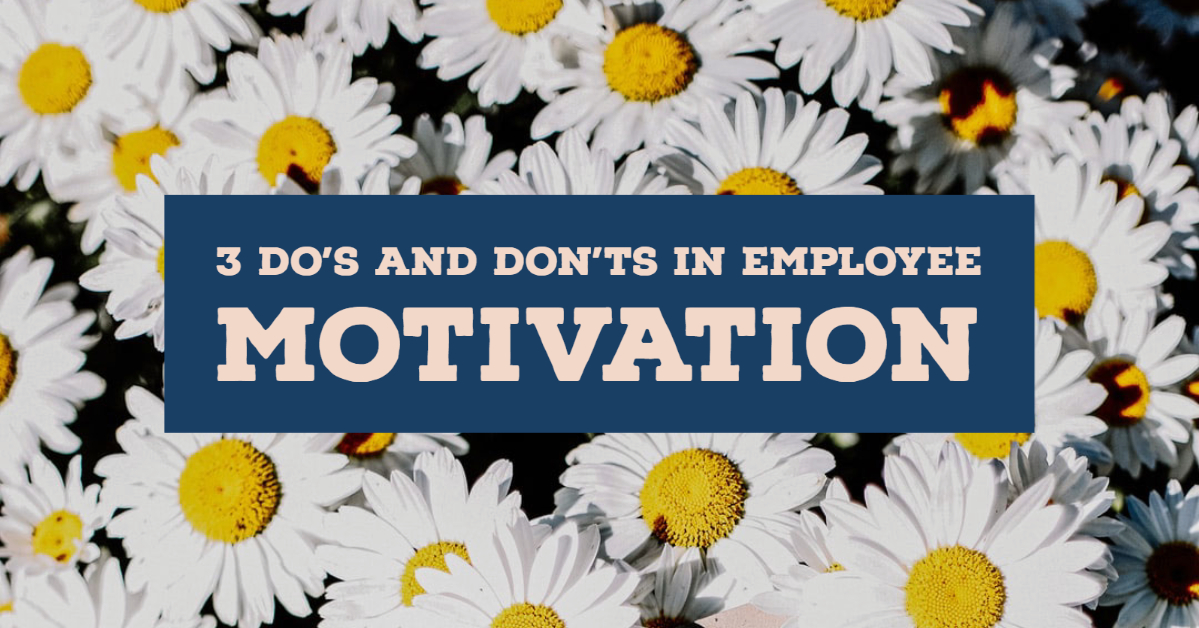3 Do’s and Don’ts in Employee Motivation
Employee motivation program is an integral component of a successful and productive workplace. When employees are motivated, they are more engaged, enthusiastic, and committed to their work. This leads to higher job satisfaction, increased productivity, and improved overall performance. Understanding the importance of employee motivation is crucial for employers and managers who strategies to build a positive and thriving work environment.
Motivated employees not only produce high-quality work but also contribute to a positive company culture. They are more likely to collaborate effectively with their colleagues, take initiative, and go above and beyond to achieve the organization’s goals. Moreover, employee motivation has a direct impact on employee retention. When employees feel valued, recognized, and motivated, they are less likely to seek opportunities elsewhere. Therefore, it is essential for organizations to prioritize employee motivation to create a loyal and dedicated workforce.
The Do’s of Boosting Employee Motivation
To effectively boost employee motivation, employers and managers should follow several key practices. First and foremost, it is crucial to provide clear and attainable goals. When employees understand what is expected of them and have a clear roadmap for success, they are more motivated to achieve those goals. Additionally, recognizing and rewarding employees’ achievements is a powerful motivator. Whether it is a simple acknowledgement or a tangible reward, recognizing employees’ hard work fosters a sense of accomplishment and motivates them to continue performing at a high level.
Another essential “do” of employee motivation is fostering open and transparent communication. Employees should feel comfortable expressing their ideas, concerns, and feedback without fear of retribution. When employees feel heard and valued, they are more likely to be motivated and engaged. Regular feedback and constructive performance evaluations also play a crucial role in employee motivation. By providing feedback, managers can help employees identify areas for improvement and provide guidance for growth, ultimately boosting their motivation.
Furthermore, promoting a positive work-life balance is essential for employee motivation. Encouraging employees to take breaks, offering flexible work arrangements, and promoting wellness programs demonstrate a commitment to their overall well-being. Employees who feel supported in achieving work-life balance are more likely to be motivated and committed to their work.
The Don’ts of Boosting Employee Motivation
While it is important to focus on the “do’s” of boosting employee motivation, it is equally crucial to be aware of the “don’ts” to avoid potential pitfalls. One common mistake is relying solely on monetary incentives as the primary motivator. While financial rewards can be effective, they should not be the only means of motivating employees. Recognition, opportunities for growth, and a positive work environment are equally important factors that contribute to employee motivation.
Micromanagement is another detrimental practice that hinders employee motivation. Constantly monitoring and controlling every aspect of employees’ work can result in feelings of resentment, lack of autonomy, and decreased motivation. Instead, it is vital to empower employees by providing them with autonomy and trust to make decisions and take ownership of their work. This fosters a sense of responsibility and motivation to excel.
Lastly, ignoring employees’ personal and professional development needs can lead to demotivation. Employers should support and encourage ongoing learning opportunities, training programs, and career advancement. When employees feel that their growth is valued and supported, they are more motivated to invest their energy and efforts into their work.
Strategies for Employee Motivation
Implementing effective strategies for employee motivation can significantly impact workplace morale and productivity. One key strategy is creating a positive work environment. This involves fostering a culture of respect, open communication, and teamwork. When employees feel valued and supported by their peers and superiors, they are more likely to be motivated and engaged.
Another powerful strategy is to provide opportunities for employees to take on new challenges and responsibilities. This allows them to develop new skills, expand their knowledge, and feel a sense of achievement. Employees who are engaged in challenging and meaningful work are more likely to be motivated and satisfied.
Additionally, offering professional development programs and training opportunities is an effective way to boost employee motivation. These programs not only enhance employees’ skills and knowledge but also show a commitment to their growth. By investing in their development, employers demonstrate that they value and appreciate their employees’ potential.
Providing Support for Employee Motivation
Supporting employee motivation requires a proactive approach from employers and managers. One way to provide support is through regular and meaningful feedback. This includes recognizing and appreciating employees’ efforts and achievements, as well as providing constructive criticism when needed. Regular feedback sessions allow employees to understand their areas of strength and areas for improvement, which can effectively motivate them to grow and excel.
In addition to feedback, it is essential to create a supportive work environment that encourages collaboration and teamwork. When employees feel supported by their colleagues and superiors, they are more likely to be motivated and engaged. Encouraging teamwork and fostering positive relationships can enhance morale and create a sense of belonging.
Moreover, offering flexible work arrangements and promoting work-life balance is crucial for supporting employee motivation. Recognizing that employees have responsibilities and commitments outside of work and allowing them the flexibility to manage their personal lives can significantly boost motivation and overall job satisfaction.
Employee Motivation Case Studies
Examining real-life case studies of successful employee motivation initiatives can provide valuable insights and inspiration for organizations. One such case study is Company X, which implemented a recognition program to boost employee motivation. The program involved peer-to-peer recognition, manager recognition, and tangible rewards. As a result, employee morale and motivation significantly increased, leading to improved performance and reduced turnover.
Another case study is Company Y, which focused on career development opportunities as a means of employee motivation. The organization offered training programs, mentorship opportunities, and internal promotion pathways. This resulted in increased employee satisfaction, higher levels of motivation, and improved retention rates.
Implementing Employee Motivation Programs
To effectively implement employee motivation programs, employers should consider several key steps. First, it is crucial to assess the current state of employee motivation within the organization. This can be done through surveys, interviews, or focus groups to gather feedback and identify areas for improvement.
Next, organizations should develop a comprehensive employee motivation strategy that aligns with the company’s goals and values. This strategy should include clear objectives, action plans, and timelines for implementation. It is important to involve employees in the development process to ensure their needs and perspectives are considered.
Once the strategy is developed, organizations should communicate it effectively to all employees. This includes explaining the rationale behind the program, the expected benefits, and the role of employees in its success. Clear communication ensures that employees understand the purpose of the program and feel motivated to actively participate.
Lastly, organizations should regularly evaluate and measure the impact of the employee motivation programs. This can be done through surveys, performance evaluations, and tracking key performance indicators. By monitoring the effectiveness of the programs, organizations can make necessary adjustments and continuously improve their employee motivation initiatives.
Tools and Resources for Employee Motivation
Several tools and resources can aid organizations in boosting employee motivation. One such tool is employee recognition software, which allows for easy and efficient recognition of employees’ achievements. These software solutions enable peer-to-peer recognition, manager recognition, and provide a platform for rewards and incentives.
Another valuable resource is employee engagement surveys. These surveys provide insights into employees’ satisfaction levels, areas of improvement, and suggestions for boosting motivation. By gathering feedback from employees, organizations can make informed decisions and tailor their motivation strategies accordingly.
Additionally, professional development programs and training resources are essential for employee motivation. Organizations can partner with external training providers or develop internal training programs to enhance employees’ skills and knowledge. These resources show a commitment to employees’ growth and motivate them to invest in their professional development.
Access Psychosocial Hazards Books from Amazon: Psychosocial Hazards
Measuring the Impact of Employee Motivation
Measuring the impact of employee motivation is crucial to understand the effectiveness of motivation strategies and make informed decisions. One key metric to consider is employee satisfaction. Regular employee satisfaction surveys can provide insights into employees’ overall job satisfaction, motivation levels, and areas for improvement.
Another important metric is employee performance. By tracking individual and team performance, organizations can assess the impact of motivation strategies on productivity, quality of work, and overall performance. Higher levels of motivation are often correlated with improved performance outcomes.
Furthermore, employee turnover rates can serve as an indicator of the success of employee motivation initiatives. When employees are motivated and satisfied, they are more likely to stay with the organization. Conversely, high turnover rates may indicate a lack of motivation and job satisfaction.
By analyzing these metrics and comparing them over time, organizations can identify trends, assess the effectiveness of their motivation strategies, and make data-driven decisions to further enhance employee motivation.
Conclusion: Building a Motivated Workforce
Building a motivated workforce is essential for organizations that strive for success and productivity. By understanding the importance of employee motivation, implementing effective strategies, and providing necessary support, employers can create a positive work environment that fosters motivation and commitment.
The do’s of boosting employee motivation, such as setting clear goals, recognizing achievements, promoting open communication, and supporting work-life balance, contribute to a motivated workforce. Conversely, employers should avoid relying solely on monetary incentives, micromanagement, and neglecting employees’ personal and professional development needs.
Implementing employee motivation programs, utilizing tools and resources, and measuring the impact of these initiatives are crucial steps to ensure continuous improvement. By building a motivated workforce, organizations can cultivate a positive company culture, enhance productivity, and achieve long-term success.
If you’re looking to boost employee motivation and create a thriving work environment, start by implementing the essential do’s and avoiding the don’ts outlined in this article. By prioritizing employee motivation, you can build a motivated workforce that drives success.
You don’t need to worry about doing this alone! We can help you at WHS & Training Compliance Solutions. We provide a variety of workplace mental health courses which include motivating people among others. Our service area spreads through Queensland, in cities such as Brisbane, Townsville, and Cairns. Contact us 07 5499 2406 to book a class appointment.












